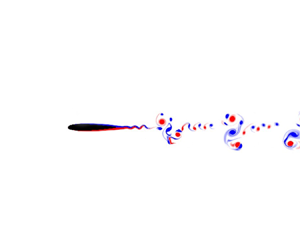Article contents
Hydrodynamics and scaling laws for intermittent S-start swimming
Published online by Cambridge University Press: 26 March 2024
Abstract

The hydrodynamics of a self-propelling swimmer undergoing intermittent S-start swimming are investigated extensively with varying duty cycle  $DC$, swimming period
$DC$, swimming period  $T$, and tailbeat amplitude
$T$, and tailbeat amplitude  $A$. We find that the steady time-averaged swimming speed
$A$. We find that the steady time-averaged swimming speed  $\bar {U}_x$ increases directly with
$\bar {U}_x$ increases directly with  $A$, but varies inversely with
$A$, but varies inversely with  $DC$ and
$DC$ and  $T$, where there is a maximal improvement of
$T$, where there is a maximal improvement of  $541.29\,\%$ over continuous cruising swimming. Our results reveal two scaling laws, in the form of input versus output relations, that relate the swimmer's kinematics to its hydrodynamic performance: swimming speed and efficiency. A smaller
$541.29\,\%$ over continuous cruising swimming. Our results reveal two scaling laws, in the form of input versus output relations, that relate the swimmer's kinematics to its hydrodynamic performance: swimming speed and efficiency. A smaller  $DC$ causes increased fluctuations in the swimmer's velocity generation. A larger
$DC$ causes increased fluctuations in the swimmer's velocity generation. A larger  $A$, on the other hand, allows the swimmer to reach steady swimming more quickly. Although we set out to determine scaling laws for intermittent S-start swimming, these scaling laws extend naturally to burst-and-coast and continuous modes of swimming. Additionally, we have identified, categorized and linked the wake structures produced by intermittent S-start swimmers with their velocity generation.
$A$, on the other hand, allows the swimmer to reach steady swimming more quickly. Although we set out to determine scaling laws for intermittent S-start swimming, these scaling laws extend naturally to burst-and-coast and continuous modes of swimming. Additionally, we have identified, categorized and linked the wake structures produced by intermittent S-start swimmers with their velocity generation.
JFM classification
Information
- Type
- JFM Papers
- Information
- Copyright
- © The Author(s), 2024. Published by Cambridge University Press
References
- 3
- Cited by


